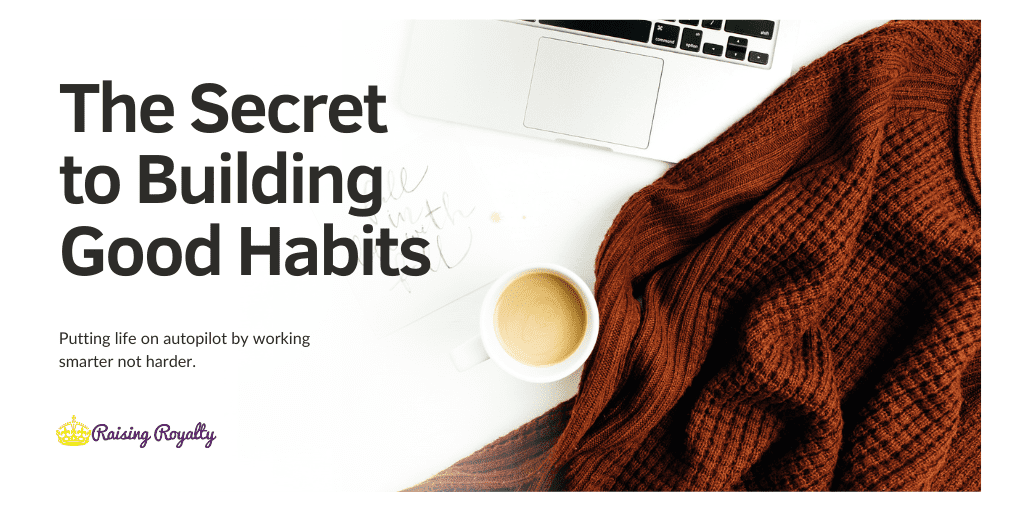

Putting life on autopilot is a dream most of us have. After all, if that to-do list would just do itself, life would be a lot easier right? But building habits is hard! It takes effort to make something effortless. So what’s the secret to build good habits?
Good habits vs Bad habits
Good habits and bad habits both have something in common: they are behaviours that are done with little or no conscious thought. You don’t think about doing it, you just do it. Usually, habits have a trigger, and most habits are so ingrained that it feels odd or strange when you don’t do them.
Obviously the difference between a good habit and a bad habit is the function. Good habits support healthy choices. Bad habits are generally unhealthy. For example, the habit of brushing your teeth before bed is a great habit, promoting good oral hygiene. The habit of nibbling junk food when sitting down to watch TV probably isn’t the best, since it can lead to unhealthy weight gain.
The Habit Struggle
We have problems when we want to build good habits because often the behaviour we want to make habitual isn’t something that can be made into a habit! Working out more, practicing a skill, or cleaning up regularly aren’t behaviours that can be habitual because they take conscious effort to do. You have to think about what you’re doing when you’re doing them. So those kinds of actions need to be part of routines rather than habits.
Actions that can be habitual are usually small and simple. For example, drinking more water throughout your day, or taking the stairs rather than the elevator, or putting down the phone while out to dinner are easily-habitual behaviours. So is checking your email first thing in the morning, getting coffee while reading the news, or wearing the same t-shirt and sweatpants style every day.
Making habits easy
Every habit has a built-in reward. That’s what makes habits — especially bad habits — easy to create. There’s an immediate feel-good feedback when the habit is repeated that encourages you to continue to repeat it.
So before you get on yourself (or your kids!) about bad habits, consider the reward that habit gives. Doom-scrolling before you get out of bed can feel like taking control by getting more info, reducing anxiety (even when it doesn’t actually, long-term) and eating sweets with your favorite show gives you instant happy brain chemicals.
In order to build good habits easily, you’ll have to trick yourself — or at least your brain — into associating the behaviour you want to make a habit with a quick reward.
Steps to building good habits
First, start by choosing the behaviour carefully.
Is this something that actually makes for habitual behaviour? How much effort will it take? Remember, habits are done automatically, without thought, so only behaviours that can be done automatically can be habits. And that’s why it’s a lot easier to end up with bad habits than it is to build good habits.
That doesn’t mean habits can’t help anchor routines, but you have to build them correctly.
For example, say my goal is to practice an instrument more often. I can’t make piano practice a habit, since that requires effort. But I can make sitting down at my piano at a certain time of day habitual, and that will remind me about my desire to practice more often.
Next, bundle the behaviour with happy brain chemistry.
Maybe that means you restrict something you enjoy doing to only when you’ve done or are doing the habit you want to build. For example, you’ll only watch your favorite TV show when you’re on your treadmill, or after you’ve cleaned the kitchen. Or maybe you make it harder to indulge in the bad habit, like charging your phone in another room at night so you stop checking email first thing in the morning.
Then, set up your triggers on purpose.
Most habits have a trigger. You get in the driver’s seat of your car, and immediate reach for the keys to start it. Go into a kitchen and you open the fridge — whether you’re hungry or not. If you sit at the computer, do you instantly open Facebook? The first action triggers the habitual action.
So pair your desired habit with something you’re already doing. For example, when you walk in your front door after work, and your goal is to go for a walk instead of watching tv, try changing your shoes right away. The action of opening the door will trigger the habit of taking off your shoes when entering a house, then putting on the other ones for that walk. One triggers the next, which leads to the next.
Finally, repeat.
All habits are simply repeated behaviours. So in order to turn a behaviour into a habit, you’ll have to repeat it until you no longer need to think about it.
How many times you need to repeat the behaviour before it becomes a habit depends on a few different things. It depends on how much effort is required for the behaviour, what the reward is, and how often you repeat it. Easy actions with big rewards (like pre-mixed chocolate smoothies for breakfast) won’t take more than a few days to become habitual. But stopping a bad habit, such as hitting the snooze button more than you should in the mornings, may take a month or more before the habit changes.
Habits take patience
To build good habits – and break bad habits – requires patience, support, and training. Another word for habit is just discipline. It takes will-power to create habits or break them. And sometimes that means you need help.
So share your goals with others. Don’t just share the goal, share why you want it and what tends to stop you. Just the act of sharing will help you stay accountable, and the people who love you will gently remind you about it, if only so they can celebrate with you.
Set up your environment for success with your habits. Remember, habits are effortless behaviours. So make it easy to do the action! Keep a water bottle beside your computer, move the phone chargers out of your bedroom, and put your running shoes right by the front door. It’s easier to do something when everything you need to do it is at your fingertips.
And celebrate those achievements. If you’ve gone a full day without reaching for the junk food, reward yourself (though not with junk food!) Sticker charts work just as well for adults as they do for kids, and adult money gives us many more choices!
Whether you’re wanting to build a new good habit or break an old one, it takes time. Be patient with yourself and don’t give up just because you forget once or twice. Keep going and pretty soon, you won’t even have to think about it. It’ll be a habit!




